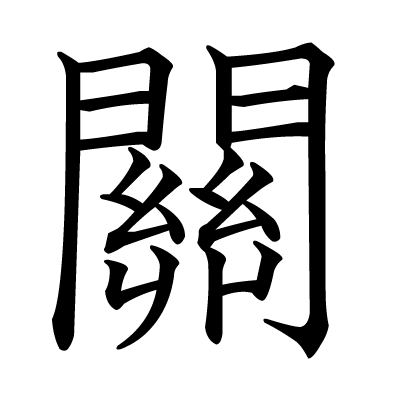Know Your Characters: A Zen Glossary
Editor’s note: This an occasional series introducing some of the basic words and expressions used in Zen practice in their original form, as Chinese characters. Although the Kwan Um School of Zen is a Korean school, the root vocabulary of Zen is classical Chinese, shared by all traditions in China, Korea, Japan, and Vietnam (and now around the world).
Character 4: Kwon, 關
This character looks more intimidating, doesn’t it? Kwon or Guan means “gate,” “checkpoint,” or “border entry,” as in Zen Master Seung Sahn’s Ten Gates, or the famous collection of kong-ans, the Mu Mon Kwon, which is sometimes translated as “No-Gate Checkpoint,” “Gateless Gate,” “Gateless Barrier,” and so on.
In this case, as with many Chinese characters (but not all), the different parts of the character can explain how we understand this word. Kwon is made up of two parts: 門, which means “door” or “gate,” and is pictographic, meant to look like two sides of a swinging door, and an archaic form of 幺, which means “to weave with threads.” So this word combines the meaning of “gate” with a sense of connection or intersection. In ancient Chinese, it referred to a frontier pass or checkpoint where documents or identification would have to be produced. In modern Chinese, it is used in the common expression guanxi, which means “connections” or “relationship.”
Kwon is an apt word for Zen teaching, because it embodies the spirit of kong-an practice, where the student and teacher meet at a checkpoint (the kong-an interview) where the student must demonstrate her or his understanding. If the teacher approves, the student can go forward. But, of course, originally there is no teacher, no student, no checkpoint and nothing to check! The title of the Mu Mon Kwon (which is a play on words based on the name of the monk who compiled it, Mumon or Wumen) conveys this sense:
無 門 關
Without/no gate checkpoint
Mumon explains this further in his introductory poem. Look for the way he uses “gate” and “checkpoint” as parallel expressions:
大道無門
Great / way (Tao) / without / gate
The great way has no gate;
千差有路
Thousand / directions / is, has / road
Its roads go in a thousand directions.
透得此關
Cross, travel through / attain / this / checkpoint
Pass through this checkpoint,
乾坤獨步
Heaven and earth, the world / alone / walk
And you will walk alone between heaven and earth.
Zen Master Seung Sahn’s book Ten Gates also contains an introductory poem called “Ten Gates,” which ends like this:
Originally, there is nothing.
How do you open and close?
The mouse eats cat food but the cat bowl is broken.
DO!
Through the gates—north south, east west.
The “Do” here is the character 道, that is, Tao, path, or way, pronounced “Do” in Korean. (Stay tuned for another edition of Know Your Characters about 道 and its many uses).
Here is a highly stylized calligraphy of the characters Mu Mon Kwon by the Japanese calligrapher Tōjū Zenchū.
________________________
Woodfish, Spring 2015
On Magic, Attachments, and Righteous Indignation by Zen Master Wu Kwang




